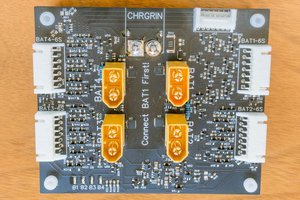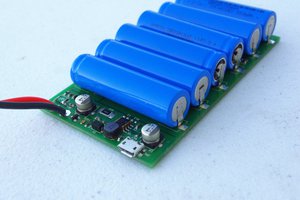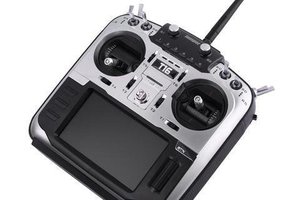Coin Cell Challenge...
Lithium coin cells are convenient energy stores for projects. Not safe if swallowed though. Can we do better?
Lithium coin cells are convenient energy stores for projects. Not safe if swallowed though. Can we do better?
To make the experience fit your profile, pick a username and tell us what interests you.
We found and based on your interests.
This log is a quick one to introduce an intriguing potential alternative to coin cells. I have been waiting for weeks for the module to arrive and then another week to make time to poke around with it. Inthe log where I shortlisted potential alternatives to coin cells for small projects such as "learn to solder" badges that would be suitable for children, I mentioned voltage-boosted AAA cells. The ME2108 series of boost converters nicely matches the brief on paper. Don't go looking at your usual distributors for ME2108 - you will find some very pricey Analog Devices and Vishay buck converters. Those are not the PMICs you're looking for....
Instead, turn your browser towards the exciting land of lcsc.com, where Nanjing Micro One Elec (and doubtless others too) have a range of DC-DC converter offerings. The ME2108A (you can go up to F with a variety of external transistor and chip-enable permutations) is what has appeared on many of these little 0.8-3.3V boost modules from eBay, Aliexpress etc. Here's the datasheet. Two key features make them attractive to me, in the context of Coin Cell Challenge:
However, I can already sense there are disadvantages with this approach. The key one, other than the additional minor complexity and expense (depending on your comparison) to your BoM, is that these aren't going to be the easiest to switch off to a very low quiescent current in the existing module format more on that later. Also, the form factor of the AAA battery - it's OK, not as slim as a a coin cell (10.5mm plus your holder/clip for AAA vs 4.5mm for a CR2032 SMD holder) but we also need some PCB space for those supporting components.
Here's how these eBay modules come wired up (from the datasheet diagrams):
And here's the main IC with the caps on the front:
And here are the the diode and inductor:
I haven't checked the values of the onboard components but it looks like a 22uH inductor. The pricing for these is $2-3 in single quantity with reasonable delivery time or less than $0.5 in qty 8 from e.g. Aliexpress.
The initial test was for a DC load through an LED with a potentiometer to adjust the current:
I measured the voltage across the battery terminals and the voltage across the converter output under load. I also measured both the current flowing in the battery-converter circuit and the converter-LED circuit. I varied the LED current from 4mA to 30mA (sorry, LED) and the results are below:
This is the rather messy graph of that table (log scale on the left, liniear on the right :-) :
My main takeaway is that it works! But not the best. Maybe that's the implementation of the module components. Maybe the ICs on the module aren't the Nanjing Micro One Elec version (highly likely). But it works. The battery in my test was AA, rather than AAA, so there may be a greater...
Read more »So, I did the first experiment with supercapacitors and spit tonight. Not particularly rigorous but still interesting.
The control was the same as for the coin cell experiment: a 5g acrylic jar with spit in it.
The test setup started with a pair of 3F 2.7V Cooper Bussman EDLCs wired in series. They were charged through a 20 Ohm resistor to 4.9V.
The part of the circuit which was submerged in spit was an attempt to realistically recreate what a badge might look like (as far as electrolysis of spit is concerned). I used a piece of protoboard with some spare LED legs that had been clipped off as extensions to six 0.1" header pins.
The furthest pin was connected with the red wire to the 4.9V leg of the higer voltage supercap. The next furthest pin was connected (orange wire) to the ~2.45V middle where the two supercaps connected to each other. This represented one capacitor pair of pins being submerged. Then I left a gap of two pins to represent the fact there would be spacing between the legs of the pair of supercaps. Then the second nearest was connected to the 2.45V midpoint (yellow wire) and the nearest pin was connected to the negative terminal (green wire) of the lower potential supercap / ground.
Here's the whole thing fizzing* away once I submerged the "probe":
*it didn't fizz but I'm sure there weren't that many bubbles there when I made the spit sample...
Here's the discharge curve. Experiment stopped at 109 minutes, slightly short of the previous experiment. Final voltage was 1.1V. The irregularity of readings (to fit around my dinner time) would embarrass my science teachers.
And here's the litmus test result:
As you can probably guess, the control sample is at the top and the supercap sample is below. I would say we're definitely looking less caustic than the coin cell, at around pH 10 or so, but I still wouldn't want this lodged in my gullet!
I was slightly surprised that, relative to a CR2032, the increased spacing of the pins and wires, combined with a lower total energy stored, didn't lead to a less caustic outcome than the results show. This should prove for an interesting test of the hypothesis that increasing the shortest electrical path between the anode and cathode in coin cells would significantly reduce the pH of the resultant hydrolysed saliva.
The really nice thing about supercaps, though, is that they can be soldered into the PCB of a badge and left there, being charged in place and never (in all likelihood) needing replacing. If your badge is larger than a CR2032 and you can run it on supercaps, you have a decent chance of being safer purely because your badge is harder to swallow than a cell on its own.
For those who are wondering, the supercaps I used are a nice size if you are thinking about badge mounting. At 20mm long and 8mm diameter, they feel like a roughly AAA replacement size (albeit a little longer if you have them end to end) but with more options to place around a board. Two easily fit on a 1" square PCB, laid flat. Just think about whether you need to glue or otherwise fix the non-leaded ends down mechanically. Wouldn't want them being pulled off the PCB.
I'll leave it to someone else to provide the nice calculations on how many Joules were used to hydrolyse the saliva in this experiment.
This is just a short run-down of the thought process going into selecting alternative energy stores
I'm sure there are probably more requirements (other aspects of safety). From these, I assessed the following alternatives to lithium primary CR2032:
In which we try to answer:
Warning, this log is not going to look nice if you are squeamish about spit
I ran a basic experiment to answer this. From the previous log, we found out that hydrolysis of tissue fluids was believed to be the main mechanism of harm to people who swallow coin cell batteries. If we could use saliva as a proxy for the "tissue fluids" found in the throat/oesophagus, we could expose them to the sources of current provided by the coin cells and set a baseline against which to try and improve our energy stores. I don't know why we didn't do this experiment in school - it was rather fun.
Measure your coin cell voltage with the voltmeter/DMM. Nominally they are 3V but open circuit they can be 3.3V for a new one.
Add your coin cell with the anode (negative terminal) facing down. Bear in mind that anode and cathode can get switched around when people describe coin cell electrolysis. We're going to refer the anode (smaller face) and cathode (positive, often marked with an etched or stamped "+" and wraps round the sides of the cell) as they are marked on the cell.
Start your stopwatch/timer and put the lids on the jars. I did this experiment at around 18°C although the reaction in the case of the battery being actually swallowed is going to be much nearer 37°C.
After 2 hours have elapsed, put on whatever protective equipment or clothing you deem necessary. Put a drop of bleach in the remaining jar and open the lids of the two saliva jars.
Get your litmus paper and colour chart ready for comparison. Dip a piece of litmus paper in the control sample of saliva and note the colour score from the colour chart. Then repeat for the coin cell saliva sample and the bleach. Be quick making your comparison with bleach - the litmus colour starts to quickly fade as it is bleached... ...by the bleach.
Use the tweezers to remove the coin cell from the saliva. Wipe it down with the absorbent material and measure the voltage. Dispose of battery, bleach and saliva samples safely and wash containers.
So, bleach is around pH 12, (my) saliva is around pH 7 and saliva-hydrolised-by-CR2032 for two hours seems to be between pH 10-13. From a rough comparison of the open circuit voltage between the start (3V) and end (2.8V) of the 2 hour test, using the chart in this analysis of coin cell capacity, we may have used ~150mAh or, at 2.7V (the voltage when the current was flowing), ~1500 J.
Given the effect of the hydrolysis on the saliva, I conclude that we can use saliva as a proxy for oesophageal fluids in future tests. As a baseline, it appears that a 2hr exposure of a small quantity of saliva to a new CR2032 cell makes something almost-as or as caustic as bleach.
Many of us "know" that coin cells need to be kept out of reach of young children as swallowing them is bad.
I wanted to find out "what kind of bad" swallowing a coin cell was, so that information may help select a better alternative. The best information I found was from the US National Capital Poison Centre, which says this about itself:
The National Capital Poison Center, founded in 1980, is an independent, private, not-for-profit 501(c)(3) organization. In recognition of its high quality, the Center is accredited by the American Association of Poison Control Centers. The Center is not a government agency.
They have a page all about Mechanism of Battery-Induced Injury which is a good meta/literature search. Their key findings are that there are three main mechanisms of injury, in priority/severity order:
Personally, I was expecting mechanism 2, but not mechanism 1. I wondered if we could recreate the mechanisms in a semi-controlled way, as a means to evaluate any safer alternatives. Read on to the next log if you want to see more.
So, now we have insight into what mechanisms of injury battery swallowing causes, we can start to hypothesise what measures could avoid or reduce the severity of a swallowed battery. By the way, as we're going to look beyond conventional batteries, we should probably use a term like "swallowed energy store" instead of "swallowed battery".
We'll consider and test some or all of these in future logs.
Create an account to leave a comment. Already have an account? Log In.
Hi @coenraad , from your questions that you would find the linked Poison Control webpage very informative. Specifically for lithium cells they say that the contents aren't a pH concern in terms of leakage (although alkaline cells are) and that orientation of the contact with mucus/tissue is relevant.
This project isn't going to go too deep into reproduction of the lesser mechanisms of injury. The initial experiment was to find a proxy for the most significant mechanism of injury although I'd welcome people reproducing it and running other tests for alternative mechanisms.
For now, my focus will be on devising and evaluating alternatives to coin cells against the primary mechanism of injury.
Another two methods could be:
1. Coat the battery is something that induces vomiting
2. Pre-coat the battery in something to correct the pH
Neither are ideal but are probably better than the alternatives.
0. Make them taste awful, so they spit them out immediately. Something like Bitrex, which makes it taste bitter. You have this in e.g. sprays, and nailpolish (nailbiters).
I imagine that simply increasing the effective distance between the electrodes would drastically reduce the current and its effects. CR2032 and similar cells have a sub-millimeter gap between the electrodes around the whole circumference. Isolating the outer region of the negative electrode with a non-conductive annulus would keep the battery compatible with most existing receptacles.
That's definitely worth trying to find whether it makes a difference. Although I wonder if the reliance on modifying cells would be something that the eventual user could be relied upon to do. Or have I missed your point?
Increasing the distance between the electrodes could be as simple as providing some heat shrink cover that isolates all but two opposite points on the battery. You could probably test this theory with some carefully applied tape.
Well... I was thinking bigger. -IF- indeed, isolating the outer annular region of the negative contact makes coin cell batteries safer, I see no reason why manufacturers wouldn't be interested. If they were not, a sticker with that shape would be very cheap to make and easy for users to add to existing batteries. For sure it would be easier than trying to get rid every IEC 60086-3 battery design out there.
Ah, I see. That would definitely help existing designs become safer, assuming it helps - as you say.
The manufacturer could apply some e.g. red lacquer to the edges. That way you could easily differentiate between them and unmodified CR2032s. Shouldn't be to expensive to add this step in manufacturing. And you can market them as Child Safe(r).
You probably need some kind of label to indicate that a device is compatible with this "new" child safe battery. Again, device manufactures can market this Child Safe.
I like this idea; provided that this is actually effective.
Nail varnish was going to be one way I'd try this in the test, as well as the PVC tape idea. Not sure if I'd have the gumption to label the modified ones "child safe" though!
Swallowed batteries are no joke, and it's not even just a hazard for toddlers. My daughter popped a neodymium magnet in her mouth when she was about 10, just to goof on her brother. When he lunged at her, she swallowed the thing inadvertantly. Not a battery, of course, but same form factor, and thankfully it was only the one. So I applaud this project and look forward to updates.
As a side note, fishing for magnets in poop with a screwdriver is not as fun as it sounds.
I tend to be very careful with these batteries, ever since I got a dog. I'm interested in what you might find, as an alternative.
(PS. there are some alternative battery holders, that might be more suited for soldering tutorials with kids. Those metal clips just aren't very nice. The are very thin though.)
First tests complete. Findings here: https://hackaday.io/project/164674/log/161196-spittle
This!
Also, check out the safety warnings on this CR2032 datasheet:
http://data.energizer.com/pdfs/cr2032.pdf
and also:
Become a member to follow this project and never miss any updates

 Bud Bennett
Bud Bennett
 Patrick Van Oosterwijck
Patrick Van Oosterwijck

 Ted Yapo
Ted Yapo
Gastric acid has a pH much lower than 7... closer to 1. I think you should repeat the experiment with some pool acid and see how long the cell lasts.
Not having gastric acid is not much of a problem - the stomach is protected from the acid by a thick slime membrane, when something punches through it is when you get an ulcer, which is the acid burning your actual stomach - people with ulcers are often prescribed "proton pump inhibitors" - that stops the stomach from producing H+ for a few hours. The acid is only there as an antiseptic, curiously it supposedly doesn't aid digestion much. (You don't have this slime lining in your throat, that is why you get heartburn if the acid is pushed up your throat by the contents of your stomach... supposedly by making it either too full, or filling it with things that float.)
Questions: what would this cell do to the protective mucous, if it were lying on top of it? Does it matter which side touches the mucous? How will it react to your intestines? If the contents leaks out, what does that do?